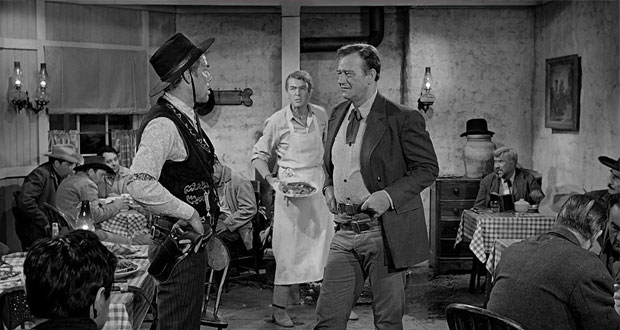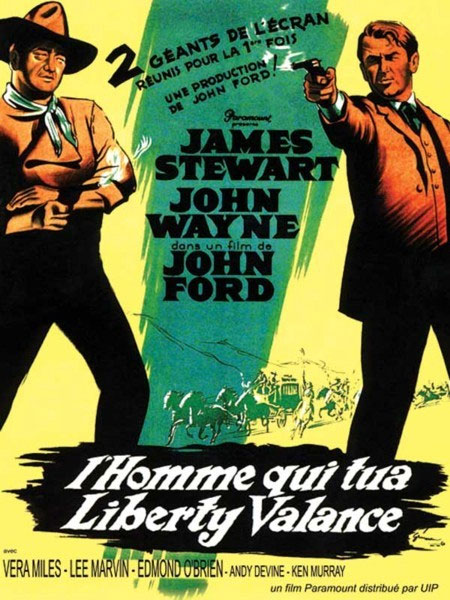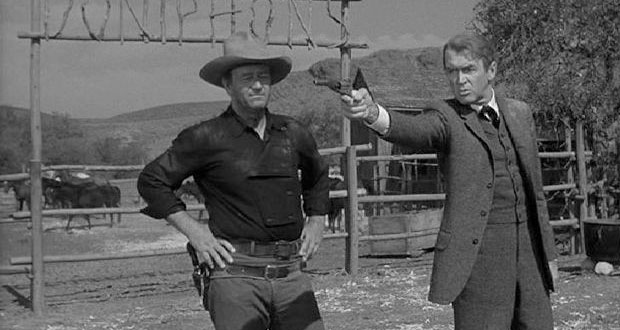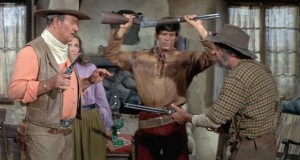I know nothing about Westerns. Didn’t see the appeal when I was younger. I avoided them so fastidiously that I probably didn’t see my first until I was twenty. I’ve seen the odd one here and there. The original True Grit. 3:10 To Yuma. Django Unchained. It was only this year that I had any inclination to start exploring the genre. I started with The Man Who Shot Liberty Valance, directed by John Ford.
When John Ford began teaming up with John Wayne, they collectively made a series of films that comprise some of the genres greatest hits. In a span of three decades, Ford would make Stage Coach, Fort Apache, Rio Grande and The Man Who Shot Liberty Valance, all highly regarded and much loved Westerns.
The Man Who Shot Liberty Valance is considered one of Ford’s finest films. It features a stacked cast including James Stewart, Lee Marvin and Vera Miles. Watching the film, I observed that like the best films in the horror genre, it offers some pretty interesting political and social commentary that underlies the events that take place.
James Stewart plays Ransom Stoddard, an American senator. We are introduced to him at the start of the film arriving at the town of Shinbone via steam locomotive and visiting a funeral. Stoddard is there to pay his respects to the deceased Tom Doniphon. As he starts a conversation with the funeral director, we flash back to the dying days of the Wild West and how the two came to meet.
Stoddard arrives in Shinbone many years prior as a young attorney when his stage coach is accosted by the bandit Liberty Valance, played with a distinctive cocky swagger by Lee Marvin. Valance robs the passengers and when Ransom protests, he pistol whips him to within an inch of his life.
Stoddard is nursed back to health and revived in Shinbone by the beautiful and compassionate Hallie. Through Hallie, we learn that Shinbone is a little town that is at a crossroads. They are about to hold a vote on whether they should enter statehood. The farmers want it, the cattlemen do not. The proponents for statehood wish for stability and the rule of constitutional law. The detractors believe that in order to protect themselves from the likes of Liberty Valance, they need guns, not bureaucrats.
One such detractor is the ice cool Tom Doniphon. When Liberty walks into Hallie’s diner and begins tormenting Ransom and the other customers, he steps in and restores order. The stand off between Liberty and Tom is intense. They are two intense alpha males that can both effectively communicate how quickly they can end the other by a few choice words and a hand hovering over their six shooter. Clad in an apron and covered in slop, Stoddard seems weak and pathetic by comparison.
Although its clear that Tom Doniphon has the measure of Liberty Valance and is the man to keep the peace, he is also the last of a dying breed in the Wild West. American is modernizing and he is unsure of his place. His own insecurities come to fore when he realizes that Hallie has eyes for Ransom Stoddard and not him. Stoddard represents education, modernity and order. He carries books with him wherever he goes and he begins teaching the illiterate Shinbone townsfolk how to read. Doniphon seems unsure of his place in it all.
What surprised me watching The Man Who Shot Liberty Valance was the absence of famous Western tropes that I thought were synonymous with John Ford and John Wayne. The film does not have a saloon that ends every night with a bar fight. There aren’t any shoot outs on horseback. No lassoing and no Red Indians brandishing tomahawks. Instead the violence and lawlessness is mostly inferred. At the heart of the film is a debate about gun ownership and the role of government in American society that feels surprisingly relevant and topical, even fifty years after the film’s release.
Does Ford choose a side? I’m not so sure. John Wayne’s Doniphon is clearly the strong arm of the law. He is the man who shoots Liberty and without him, Shinbone would have fallen into lawlessness. By comparison, James Stewart’s Ransom Stoddard is a lot of talk. He is learned but he can’t shoot to save his life. He spends most of the film looking thoroughly emaciated, draped in his apron and getting physically bullied by both Liberty and Tom.
But it is Stoddard who is the way of the future. He gets the girl. He gets the credit for shooting Liberty and he is the man who drags Shinbone into the Twentieth Century. In the modern America, it is implied that there isn’t room for Tom Doniphon, no matter how much we might admire his heroics.
The Man Who Shot Liberty Valance is a terrific film. I have no way to gauge its merits compared to other Westerns but I think the film stands on its own two feet exceptionally well. It is smart, insightful and asks plenty of interesting questions about the roots of American gun culture. All three leads, Wayne, Stewart and Marvin, are immense in their particular roles. Wayne has an assured bravado that makes him a massive screen presence. He has an economy with his words and actions that can infer plenty. Marvin owns his role as a psychopathic bully. He picks on the meek and timid with a self assured sneer but when The Duke steps him, he’s quick to hightail it. Jimmy Stewart is great as the educated lawmaker trying to bring civility to Shinbone.
I’m not sure where I’ll go next after this. I’m tempted to go all in on watching more Ford and Wayne collaborations. But I’m worried it’s all downhill from here. I’m also considering the Sergio Leone’s Man With No Name trilogy. Regardless, I’m sold on Westerns. And it looks like I’ve got plenty to explore.
Review Overview
RATING
CLASSIC
Summary : A smart, apolitical Western that doesn't feature the usual genre tropes. Worth watching for the performances from all three leading men.
 The FAT Website est. 1999
The FAT Website est. 1999






